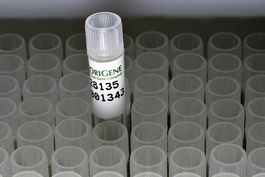GDF7 (NM_182828) Human Tagged ORF Clone
CAT#: RC214715L4
- LentiORF®
Lenti-ORF clone of GDF7 (mGFP-tagged)-Human growth differentiation factor 7 (GDF7)
"NM_182828" in other vectors (4)
Product Images

Specifications
| Product Data | |
| Type | Human Tagged ORF Clone |
| Tag | mGFP |
| Symbol | GDF7 |
| Synonyms | BMP12 |
| Vector | pLenti-C-mGFP-P2A-Puro |
| E. coli Selection | Chloramphenicol (34 ug/mL) |
| Mammalian Cell Selection | Puromycin |
| Sequence Data |
The ORF insert of this clone is exactly the same as(RC214715).
|
| Restriction Sites | SgfI-MluI Cloning Scheme for this gene |
| ACCN | NM_182828 |
| ORF Size | 1350 bp |
| OTI Disclaimer | The molecular sequence of this clone aligns with the gene accession number as a point of reference only. However, individual transcript sequences of the same gene can differ through naturally occurring variations (e.g. polymorphisms), each with its own valid existence. This clone is substantially in agreement with the reference, but a complete review of all prevailing variants is recommended prior to use. More info |
| OTI Annotation | This clone was engineered to express the complete ORF with an expression tag. Expression varies depending on the nature of the gene. |
| Reference Data | |
| RefSeq | NM_182828.2, NP_878248.2 |
| RefSeq Size | 1994 |
| RefSeq ORF | 1353 |
| Locus ID | 151449 |
| Protein Families | Adult stem cells, Cancer stem cells, Druggable Genome, Embryonic stem cells, ES Cell Differentiation/IPS, Secreted Protein, Stem cell relevant signaling - TGFb/BMP signaling pathway |
| Protein Pathways | TGF-beta signaling pathway |
| MW | 30.9 kDa |
| Gene Summary | This gene encodes a secreted ligand of the TGF-beta (transforming growth factor-beta) superfamily of proteins. Ligands of this family bind various TGF-beta receptors leading to recruitment and activation of SMAD family transcription factors that regulate gene expression. The encoded preproprotein is proteolytically processed to generate each subunit of the disulfide-linked homodimer. This protein may play a role in the differentiation of tendon cells and spinal cord interneurons. A mutation in this gene may be associated with increased risk for Barrett's esophagus and esophageal adenocarcinoma. [provided by RefSeq, Sep 2016] |
Documents
| Product Manuals |
| FAQs |
| SDS |
Resources
Other Versions
| SKU | Description | Size | Price |
|---|---|---|---|
| SC122219 | GDF7 (untagged)-Human growth differentiation factor 7 (GDF7) |
USD 760.00 |
|
| RC214715 | GDF7 (Myc-DDK-tagged)-Human growth differentiation factor 7 (GDF7) |
USD 420.00 |
|
| RG214715 | GDF7 (GFP-tagged) - Human growth differentiation factor 7 (GDF7) |
USD 460.00 |
|
| RC214715L3 | Lenti-ORF clone of GDF7 (Myc-DDK-tagged)-Human growth differentiation factor 7 (GDF7) |
USD 620.00 |
{0} Product Review(s)
Be the first one to submit a review






























































































































































































































































 Germany
Germany
 Japan
Japan
 United Kingdom
United Kingdom
 China
China
